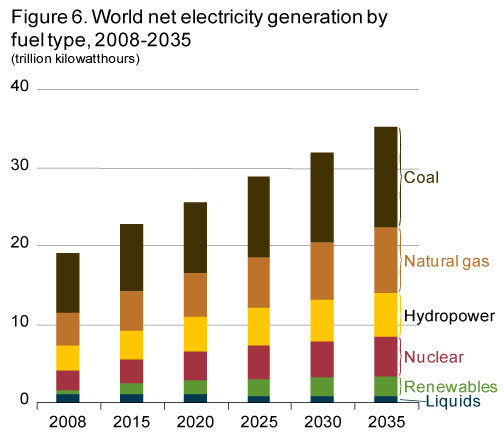Coal Is Becoming Both Versatile and Clean
Technology for turning coal into electric power, process heat, and liquid fuels has come a long way over the past ten years. And science and engineering have just begun developing cleaner and more efficient ways of utilising coal for heat, power, and transportation fuels.
The table above reveals the superior yields and efficiency of direct coal liquefaction (and hybrid liquefaction) as compared to gasification plus Fischer Tropsch, or indirect coal liquefaction.
The presentation summary above describes some economic advantages of direct coal liquefaction over indirect liquefaction -- including lower startup costs.
The CTL approach depicted above utilises methane as a hydrogen donour in a unique liquefaction process which utilises gasification plus methanol production. The methanol can be further converted to diesel or jet fuel.
More details
This Accelergy approach to CTL utilises biomass gasification as a hydrogen donour for the coal liquefaction. At this point in time, methane is likely to be more practical to provide hydrogen.
The above image portrays three ways of CTL, including Exxon Mobil's coal to methanol to gasoline (MTG), traditional gasification plus Fischer Tropsch, and the use of biomass gasification to provide hydrogen for direct liquefaction of coal to liquids.
And just to remind you that the world is not giving up on coal for the generation of electrical power, this EIA graphic projects a steady growth in the use of coal for electrical power generation through 2035 -- consistent with the recent 2012 BP Statistical Review.

Coal is second in size only to gas hydrates as a global hydrocarbon resource. Any rational projection of future energy and fuels production would necessarily include coal.
Rather than to reject coal altogether, more intelligent energy analysts and policy-makers would do better to continue to press for cleaner, safer, and more efficient ways of utilising this massive energy source -- as a bridge to future sources of energy which can be used for many thousands of years, such as advanced nuclear fission, nuclear fusion, and hybrid fission - fusion.
The table above reveals the superior yields and efficiency of direct coal liquefaction (and hybrid liquefaction) as compared to gasification plus Fischer Tropsch, or indirect coal liquefaction.
The presentation summary above describes some economic advantages of direct coal liquefaction over indirect liquefaction -- including lower startup costs.
State-owned China Shenhua Group made a profit from its pioneering direct coal-to-liquids (CTL) project in the first half of this year (2011), raising hopes that the world’s second largest oil consuming nation may expand forays into alternative fuel production.As long as oil costs remain high (above $80 a barrel), such projects should provide healthy returns to their backers.
China has rich coal reserves but limited oil deposits. After backing CTL as a way of improving energy security and easing its growing dependence on overseas crude oil, China went cold on the technology in 2008, cancelling dozens of projects amid concerns about high production costs and the impact it would have on scarce water supplies.
The parent of China Shenhua Energy Co , the country’s biggest coal producer, produced 470,000 tonnes of oil products from coal in the first half and costs of the fuel were equivalent to crude oil prices of less than $60 a barrel, according to Shenhua Group’s General Manager Zhang Yuzhuo. _Shenhua DCL Project Proves Profitable
The CTL approach depicted above utilises methane as a hydrogen donour in a unique liquefaction process which utilises gasification plus methanol production. The methanol can be further converted to diesel or jet fuel.
More details
This Accelergy approach to CTL utilises biomass gasification as a hydrogen donour for the coal liquefaction. At this point in time, methane is likely to be more practical to provide hydrogen.
The above image portrays three ways of CTL, including Exxon Mobil's coal to methanol to gasoline (MTG), traditional gasification plus Fischer Tropsch, and the use of biomass gasification to provide hydrogen for direct liquefaction of coal to liquids.
And just to remind you that the world is not giving up on coal for the generation of electrical power, this EIA graphic projects a steady growth in the use of coal for electrical power generation through 2035 -- consistent with the recent 2012 BP Statistical Review.

Coal is second in size only to gas hydrates as a global hydrocarbon resource. Any rational projection of future energy and fuels production would necessarily include coal.
Rather than to reject coal altogether, more intelligent energy analysts and policy-makers would do better to continue to press for cleaner, safer, and more efficient ways of utilising this massive energy source -- as a bridge to future sources of energy which can be used for many thousands of years, such as advanced nuclear fission, nuclear fusion, and hybrid fission - fusion.








0 Comments:
Post a Comment
Subscribe to Post Comments [Atom]
<< Home